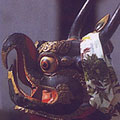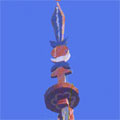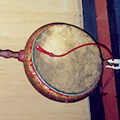The Bhutanese do carving extensively in wood, slate or stone, for making items such as printing blocks for religious texts, masks, furniture, altars, and the slate images adorning many shrines and altars. Carving, however, is not confined to wood stone and slate only – some of the most exquisite and rare carving of images of deities has been done on rhino horns and ivory and adorns various temples.
WOOD CARVING
Common to every structure are the intricate decorations – woodcarvings and brightly coloured patterns. The interiors of dzongs, monasteries, houses and other buildings are decorated with the most beautiful carved and painted wall panels, pillars, and ceilings. These beautiful hand carvings are further worked upon by painting them in vibrant colours to make them look even more attractive.
GN Mehra in his book, Bhutan land of the Peaceful dragon, says, “Timber, which is found abundantly in the country, is used lavishly for windows, doors, stairs, balconies, columns, beams, other structural members and for elaborate decorative cornices. It is this lavish and delicate use of timber in indigenous Bhutanese architecture that is mainly responsible for its very elegant and unique appearance and character.”
Murals and carvings of Lord Buddha and various other deities adorn the walls and altars of temples and shrines. The “Mandala”, a geometric design of tantric import, is a popular feature in most temples. Windows and doors are also normally painted giving the houses a very festive appearance. Floral, animal and religious motifs are mainly used as themes for the colourful paintings the most common of which are the druk (dragon), dorje, Tashi – Tagye, or eight auspicious signs, and various legendary animals. Bright traditional colours are used with the outlines usually in a lighter shade.

FURNITURE AND DECORATIVE ITEMS
The craftsmen use hard, semi-hard and soft wood to prepare functional and decorative products, hand carved and usually painted.
Carved panels are also found on Bhutanese tables and other items of furniture such as cabinets, low divans, partition screens, mirror-frames and jewellery boxes. Most beautiful wood carving found on small folding tables called chodrums that are nearly always painted.
Wooden sculptures are usually made of blue pine or walnut, as they are soft and therefore very good for carving. The products could be decorative items like dragons, masks, eight lucky signs, etc.

MASKS AND WOODEN ITEMS
The Bhutanese make masks in wood, papier-mâché or clay to represent mythological characters and the masks represent both real and mythical animals. They are available in different sizes, painted or unpainted. These masks are used in the sacred, religious, masked dances in which large numbers of human characters, animals or gods or mythological figures are depicted with the help of masks.
Animal masks are also popular as decorative items and are fashioned from one piece of semi hard wood and painted with mineral colour paints.
WOOD PRINTING BLOCKS FOR RELIGIOUS TEXT
The text of religious books is either written by a calligrapher or printed by xylography. Xylography entails carving the text in reverse on a wooden board, coating the plank with ink and then pressing a sheet of paper on to it with a roller; the printed text appears on the page the right way around.
It is possible to see some of these books, printing boards and paper at the National Library in Thimphu, collection of 9,000 printing boards.

WOOD PRINTING BLOCKS FOR RELIGIOUS TEXT ON PRAYER FLAGS
Like the blocks used in xylography, traditionally the carver used to make the blocks to print the prayer flags. The blocks are carved in reverse so that when printed with ink they are correctly printed. Flags are now being printed in India and other places and sold ready made.
more on prayer flags
STONE SCULPTURE
In Bhutan sculpture in stone was not as popular as stone is difficult to carve. This medium was mostly utilised in carving out bas-relief used for the outer walls of chhortens and monasteries, and generally depicted the portraits of the Siddhas, images of Tara, Avlokiteshwara and Guru Rimpoche. It was also used for cooking utensil in Bhutan, but has become very scarce.

SLATE-CARVING
Slate carving, an ancient Chinese art, was once done extensively in Bhutan to represent religious figures and deities. The carving used to be done on slate panels of approximately 40 X 30 cm and consisted of images of deities and inscriptions of mantras. These carved slate panels formerly adorned the exterior of temples and monasteries, and were also set into walls of chortens. Some fine specimens of this art can be seen in Simtokha dzong.
Mining of stone and slate is being done in the Wangdi Phodrang Distt. While slate is easy to carve it is also heavier and more expensive than stone.
This art form is now receiving the patronage of the Royal family.

PRODUCTS
Slate carvings to represent religious figures and deities
Wood:
Chodrum: elegant folding table traditionally used as a portable unit. The three sides are carved and painted -with dragons, flowers etc..
Dramnyen The Bhutanese guitar has an external scroll with an elaborate dragon design. The long fingerboard is usually decorated with auspicious signs accented with gold paint. Strings are of silk/nylon the sound box f one hollowed wooden section and the sound board of specially treated goat skin.
Darts (Khuru) and Targets (Bha)
Khuru is a popular game in Bhutan, resembling the game of darts except for the setting up of targets. For khuru, two targets are set apart at a distance of one’s choice. It is played between two teams on the basis of the best of three of five games of five, seven, eleven, fifteen, twenty-one or twenty five points depending upon the number of players.
The darts are made from wood and feather.
Altar (Chhoesham)
A variety of designs exist, each embellished with exquisitely painted traditional motifs.
Lute (Dranyen)
Wood & gaot skin
The Bhutanese lute has an elaborate dragon design. The long fingered board is usually decorated with auspicious signs in bright colours. The hollowed wooden section is covered with treated goat skin, and nylon strings are fastened to it. It is used by Bhutanese singers on every occasion.

Drum and Drum Stick
In Bhutan, drums are usually made of wood and inscribed with various prescribed mystic charms to ward off evil spells. They are covered on both sides with goatskin.
The stick for beating the drum is made from the wood of a tree called rushing while its handle is embellished with metal.These drums are used for all religious ceremonies and found in temples, monasteries and homes in Bhutan.
Masks
Masks are used in Bhutan for dances during festivals held at auspicious places and times, and they represent both real and mythical animals. They are fashioned from one piece of semi-hard wood, ususally pinewood, and brightly painted with mineral pigments.
Stone Pots and Utensils
Cooking utensils in Bhutan were often made of stone but today have become very rare.
Gallery
YOUR VIEWS
PRACTITIONERS: INDIA
Access 70,000+ practitioners in 2500+ crafts across India.
BIBLIOGRAPHY
10,000+ listings on arts, crafts, design, heritage, culture etc.
GLOSSARY
Rich and often unfamiliar vocabulary of crafts and textiles.
SHOP at India InCH
Needs to be written.





